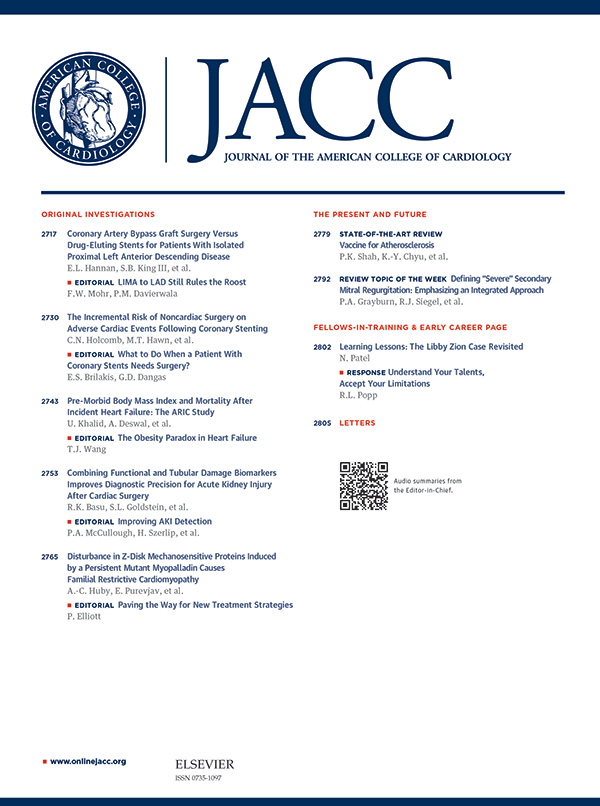Balloon Pulmonary Angioplasty for Chronic Thromboembolic Pulmonary Hypertension
IF 21.7
1区 医学
Q1 CARDIAC & CARDIOVASCULAR SYSTEMS
引用次数: 0
Abstract
Background
Chronic thromboembolic pulmonary hypertension results from mechanical obstruction of major pulmonary artery lumina with fibrotic tissue. Main treatment has been pulmonary endarterectomy, a complex surgical procedure removing vascular obstruction. However, at least 40% of patients are not candidates for pulmonary endarterectomy because of technical inoperability, comorbidities, or limited access to surgery. Balloon pulmonary angioplasty (BPA) has emerged as an interventional treatment for these patients.
Objectives
The International BPA Registry (NCT03245268) was designed to investigate BPA practice across 18 established centers in the United States, Europe, and Japan.
Methods
A total of 500 patients were prospectively and consecutively enrolled between March 2018 and March 2020, with follow-up until March 2022. Of these, 484 patients were included in the analysis set.
Results
Regional differences were seen in patient characteristics (fewer patients with prior pulmonary endarterectomy and more elderly women in Japan) and procedural details (less medical pretreatment, more jugular access, more segments and more occlusive lesions treated per session and patient, less conscious sedation, less contrast and less radiation, shorter intervals between BPA sessions in Japan). Female sex, procedure in Europe/United States, pulmonary hypertension medications at any time, and higher baseline pulmonary vascular resistance (PVR), calculated as transpulmonary pressure gradient divided by cardiac output, emerged as independent predictors of complications during BPA. After a median of 5 (Q1-Q3: 3-6) BPA sessions per patient within a median time of 4.9 months (Q1-Q3: 1.7-11.0 months), a 15-mm Hg (38%) decrease in mPAP, a 332 dynes/s/cm−5 (57%) decrease in PVR, and a 3.2% increase in arterial saturation (medians; P < 0.001) were observed, and there were significant improvements in functional class, 6-minute walk distance, serum levels of N-terminal probrain natriuretic peptide, and Borg dyspnea index. BPA complications occurred in 11.3% of sessions and 33.9% of patients and were mostly hemoptyses. No patient died within 30 days of BPA.
Conclusions
Our data are in line with previous reports on changes of clinical and hemodynamic parameters and complication rates of BPA. Centers with more experience providing BPAs were more likely to achieve a higher percentage decrease in PVR.

球囊肺血管成形术治疗慢性血栓栓塞性肺动脉高压:一项国际多中心前瞻性登记的结果
背景:慢性血栓栓塞性肺动脉高压是由纤维化组织对肺动脉腔的机械性阻塞引起的。主要的治疗方法是肺动脉内膜切除术,这是一种去除血管阻塞的复杂外科手术。然而,由于技术上的不操作性、合并症或手术机会有限,至少40%的患者不适合肺内膜切除术。球囊肺血管成形术(BPA)已成为这些患者的一种介入治疗方法。国际双酚a登记处(NCT03245268)旨在调查美国、欧洲和日本18个已建立中心的双酚a实践。方法于2018年3月至2020年3月前瞻性连续入组500例患者,随访至2022年3月。其中,484例患者被纳入分析集。结果在患者特征(日本有过肺动脉内膜切除术的患者较少,老年女性较多)和手术细节(每次患者较少的药物预处理,较多的颈静脉通路,更多的节段和更多的闭塞性病变,较少的清醒镇静,较少的对比剂和较少的辐射,BPA治疗间隔较短)方面存在区域差异。女性,欧洲/美国的手术,任何时间的肺动脉高压药物治疗,以及更高的基线肺血管阻力(PVR),通过肺压梯度除以心输出量计算,成为BPA并发症的独立预测因素。中位时间为4.9个月(Q1-Q3: 1.7-11.0个月),每位患者接受中位5次BPA治疗(Q1-Q3: 3-6次)后,mPAP下降15毫米汞柱(38%),PVR下降332达因/秒/厘米- 5(57%),动脉饱和度增加3.2%(中位;P & lt;0.001),功能分级、6分钟步行距离、血清n端脑钠肽原水平和Borg呼吸困难指数均有显著改善。双酚a并发症发生在11.3%的治疗期和33.9%的患者中,主要是咯血。没有患者在BPA治疗30天内死亡。结论我们的数据与以往报道的双酚a临床和血流动力学参数变化及并发症发生率一致。提供双酚a经验丰富的中心更有可能实现更高百分比的PVR下降。
本文章由计算机程序翻译,如有差异,请以英文原文为准。
求助全文
约1分钟内获得全文
求助全文
来源期刊
CiteScore
42.70
自引率
3.30%
发文量
5097
审稿时长
2-4 weeks
期刊介绍:
The Journal of the American College of Cardiology (JACC) publishes peer-reviewed articles highlighting all aspects of cardiovascular disease, including original clinical studies, experimental investigations with clear clinical relevance, state-of-the-art papers and viewpoints.
Content Profile:
-Original Investigations
-JACC State-of-the-Art Reviews
-JACC Review Topics of the Week
-Guidelines & Clinical Documents
-JACC Guideline Comparisons
-JACC Scientific Expert Panels
-Cardiovascular Medicine & Society
-Editorial Comments (accompanying every Original Investigation)
-Research Letters
-Fellows-in-Training/Early Career Professional Pages
-Editor’s Pages from the Editor-in-Chief or other invited thought leaders

 求助内容:
求助内容: 应助结果提醒方式:
应助结果提醒方式:


